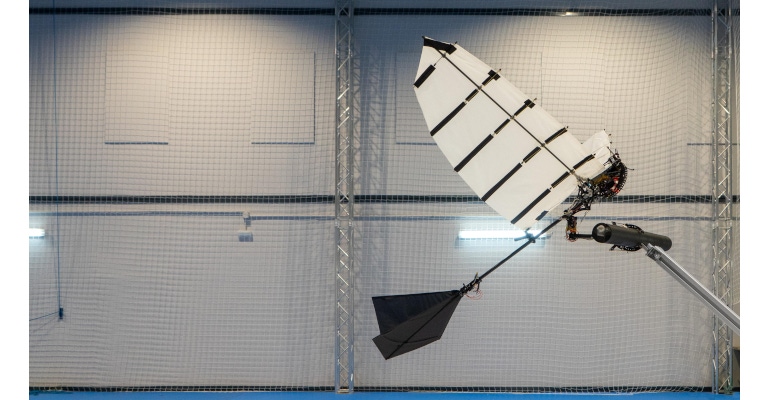Researchers developed an ornithopter with novel capabilities, expanding the potential for robot use in various applications.
February 14, 2023

Researchers have developed a robot that can land horizontally on an object and perch using a robotic claw similarly to how a real bird achieves this movement—a first for this type of flying machine, they said. The technology—developed by researchers at the Swiss Federal Institute of Technology (EPFL) and the University of Seville—demonstrates a novel achievement for flapping-wing, or ornithopter robots, they said. It potentially can expand how these types of robots are applied in commercial or scientific endeavors and also could make them more energy-efficient, researchers said.
Raphael Zufferey, a postdoctoral fellow in the Laboratory of Intelligent Systems and Biorobotics ab in EPFL's School of Engineering, built and tested the landing gear for the small winged robot—which weighs about 1.5 pounds—in collaboration with colleagues at both EPFL and the Spanish university. The technology is the first phase of a larger project that aims to create a robot to perform autonomous and useful tasks for various applications, he said.
“Once an ornithopter can master landing autonomously on a tree branch, then it has the potential to carry out specific tasks, such as unobtrusively collecting biological samples or measurements from a tree," he said. "Eventually, it could even land on artificial structures, which could open up further areas of application."
Finding the Right Balance for This Winged Robot
Researchers faced a daunting engineering challenge in creating a way for the ornithopter to land on a perch autonomously as effortlessly as birds can perform this movement, they said. In the end, they developed two robots that could achieve their design goals, testing both extensively to gauge their performance.
To achieve perch objectives, researchers had to slow the speed of the robot significantly as it perched, all the while keeping it in flight, they said. The robot also needed to perceive its environment and the perch in front of it in relation to its own position, speed, and trajectory.
The development of the claw that allowed the ornithopter hold onto its perch in and of itself was a tricky balancing act for the scientists, Zufferey said. It had to be strong enough to grasp the object and support the robot's weight without being so heavy that it couldn't stay in the air, researchers said. In fact, the team considered developing two claws for the robot similar to the anatomy of an actual bird, but the weight factor was one of several that negated this idea, Zufferey said.
To meet all of these challenges, researchers built an on-board computer and navigation system for the robot as well as a motion-capture system that helps it determine and maintain its position. They also calibrated the robot's claw so that it can maintain its focus to zero in on and grasp the perch even as the robot oscillated in flight, they said.
Another aspect of the claw for which researchers optimized the robot's control system is the ability to absorb the robot's forward momentum upon impact, as well as support its weight quickly and solidly after landing.
Rest and Recharge
Currently, most winged, flying robots—such as unmanned aerial vehicles—can merely fly, which requires continuous energy and thus limits the life of the batteries that provide their power. However, if a flying robot could stop and rest on a perch like actual birds do, it could allow them to recharge using solar or another type of renewable energy, giving them the ability to carry out longer-range missions or tasks, Zufferey said.
“This is a big step toward using flapping-wing robots, which as of now can really only do free flights, for manipulation tasks and other real-world applications,” he said.
Researchers published a report on their work in the journal Nature Communications.
Zufferey and the team plan to continue to make improvements to the device. In particular, they aim to explore how the robot can perform outdoors, a scenario that has not yet been explored, he said.
“At the moment, the flight experiments are carried out indoors, because we need to have a controlled flight zone with precise localization from the motion capture system," he said. "In the future, we would like to increase the robot’s autonomy to perform perching and manipulation tasks outdoors in a more unpredictable environment.”
About the Author(s)
You May Also Like



